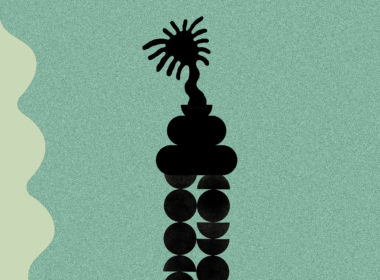If you are anything like me, the first pad you used fit and felt similar to a diaper… and your first experience with tampons ended with a lot of crying and questions about exactly how many holes were ‘down there’ (this is also a testament to the failures of the sex education program at my Minnesota public school). I was utterly SHOCKED to hear that when my mom got her period, she had to wear a belt-like contraption that held up a pad. Now, today, I can honestly report that I have been further bamboozled by my google search: “history of period products.” Before we get into different types of products on the market now, their pros and cons, and which ones are Rythm recommended, let’s take a tour through the history of period contraptions, because I promise it will not disappoint. It will also make you feel a lot better about what we use now.
The History of Period Gadgets
Have you ever heard anyone call menstruation “being on the rag?” Well, you can look back into history, long before the 1800s to find the root of this phrase. While some of the richer menstruators just stayed home while menstruating, others tucked a rag between their legs. Menstruators also sometimes sat on wine-cooked rocket (or, arugula). Helen King (a historian specializing in medical history who wrote her Ph.D. dissertation on menstruation in ancient Greece) astutely asserts in an interview with Clue that we need to remember that history has long been recorded by males – meaning menstruators of the time may have had their own secrets that males didn’t know of and therefore didn’t document. I have this amazing mental image of a secret club for menstruators with a sign on the door that says “no boys allowed” carved in marble (in ancient Greek, of course).
Going further back into history (think biblical times), it is said that women, while menstruating or recovering from childbirth, would retreat to ‘red tents’ to gather together to provide each other emotional support. I kind of think we should bring this back.
Fast forward to the 1800s, menstrual cloths made of flannel and other fabrics were still common practice. Then, during the latter half of the century and into the 20th century, innovation began, introducing the first editions of menstrual cups (made of aluminum or rubber) and rubber period pants (yes, rubber bloomers). In the the1890s, the Ladies Elastic Doily Belt that you attached a pad to came onto the market and was sold door to door. Lister’s towels, made by Johnson & Johnson, made the first disposable pad of gauze and cotton in 1896.
A huge development was a result of World War I, when nurses reported that cellulose was more absorbent than cloth – this led to the development of Kotex’s sanitary napkin which became “the first successfully mass-marketed sanitary napkin.” These developments remained mostly in the United States while reusable cloth products continued to be in use around the world.
Then, 1933 rolled around, and Tampax patents the modern disposable tampon. Tampons were a response to concerns about pads – how they irritated vulvas and how easily exposed they were to fecal bacteria. Moralist social stigmas about tampons being ‘unladylike’ persisted, but at the same time, “Mary Beatrice Davidson Kenner, a female African-American inventor, patented the sanitary belt in 1956, the first product featuring an adhesive to keep the pad in place.”
In the 1970s, beltless pads became mainstream and all of a sudden, there were options that didn’t make you feel like you were drowning in a diaper. Unfortunately, a lack of knowledge surrounding tampon use led to many cases of Toxic Shock Syndrome (TSS) over the 70s, 80s, and 90s.
Luckily, throughout this time, innovators kept doing their thing, and “reusable menstrual cups, period sponges, and biodegradable options became more popular throughout the 1970s as second-wave feminist and environmentalist movements grew.” Many people adopted free-bleeding as a way to reclaim the shame that surrounded periods.
This brings us to today when we have a variety of options available to menstruators – and thank gosh for that because I don’t think you would catch me in rubber bloomers. Let’s go into detail on all the period products available to us now.
What are period products?
Period products are any products/items that are designed to be used to manage menstruation and all that comes with it. In this blog, we will cover the different methods of blood collection, but we will also talk about products to assist in pain management, menstrual symptoms (like mood changes and digestive discomfort), and also about foods and nutrients that help make menstruating hopefully just a bit easier.
Products for Blood Collection
I realize this heading sounds a bit vampire-ish, but I promise Dracula isn’t writing this (if anything, we would hope for Edward Cullen). Did you know that your ‘period blood’ isn’t actually just blood? Your period is the result of your uterus shedding the endometrium (aka endometrial lining) when you are not pregnant. Your period is actually broken-down endometrial tissue! An average menstruator will shed about 35-40 mL of blood/tissue during their period (which is equivalent to about 2.3-2.7 tablespoons).
In terms of options for blood collection, I propose to you two main categories: disposable and reusable products. Both have pros and cons and ultimately, you have to pick what will work best for you, and that might change over time. Disposable products include certain menstrual underwear, certain menstrual discs, tampons, and pads. Reusable products include certain menstrual underwear, certain menstrual discs, and cloth pads.
While disposable products were created as a form of liberation for menstruators, reusable period products, albeit far more advanced, have gained more popularity in recent years due to efforts of sustainability. A study from 2019 estimated that 100 million women globally use on average 11,000 tampons in their lifetime. A National Geographic article estimates that “over the course of a lifetime, a single menstruator will use somewhere between 5 and 15 thousand pads and tampons.” That same 2019 study offers the startling fact that “a regular non-organic pad can take 500–800 years to break down and as plastic makes up such a large amount of these products, they will never truly biodegrade.” They continue, “tampons are significantly quicker to biodegrade at around six months, as they are mostly made from natural materials such as cotton. However, as many brands of tampons now contain plastic within them and are often wrapped in plastic, this compounds the issue.”
When I switched from disposable products to a reusable menstrual cup, environmentalism was one of the primary reasons I did so. Not only that but buying reusable products pay off in the long run because you aren’t buying overpriced and overtaxed disposable products over and over.
Disposable Menstrual Underwear
Disposable menstrual underwear are essentially like diapers for adults, or disposable underwear made for those who experience incontinence. These disposable underwear are also commonly worn after childbirth. If you are someone who has a very heavy flow, you might find that wearing disposable menstrual underwear brings you peace of mind when it comes to leaks while you are asleep.
An example of these includes Rael’s Organic Cotton Disposable Period Underwear for Postpartum/Overnight ($12 for 8).
Tampons
Tampons are made of cotton, synthetic materials, or a combination of the two. Studies have shown, though, that synthetic fibers are the ideal environment for toxin production. While some synthetic materials have been prohibited, the United States Food and Drug Administration (FDA) still allows for tampon production to include rayon – which is still a problematic synthetic material and can lead to Toxic Shock Syndrome (which will be further discussed later).
Thus, the best thing to do is use 100% cotton tampons that are not treated with bleaches, dyes, or fragrances, like the Organic Cotton Tampons from Public Goods (18 for $4.95). If you struggle with tampon insertion or you’re just trying it out for the first time, check out Marlow’s Tampon Lubricant ($8.50) to make insertion as easy as possible. Another great option is the August Build Your Own Period Supply Box (Subscription available, $8.75-$34).
Unlike other period products, there are not currently any reusable tampons that are considered safe substitutes for disposable tampons. If you do want to be more sustainable and also continue to use tampons, think about using a reusable tampon applicator – like the Dame Reusable Tampon applicator ($23) – with organic tampons that do not come with an applicator.
Disposable Pad
Similar to tampons, you should be picky about what ingredients are in your pads which can also contain chemicals that are harmful to the body. For example, dioxins are toxins that result from the bleaching of cotton and wood in production. It’s best to use 100% cotton pads like Rael’s Organic Cotton Pads (16 for $7) and for liners, you could use Rael Organic Liners (70 for $7).
Disposable Menstrual Discs
One major perk to disposable menstrual discs is that you can have intercourse, or penetrative sex, while wearing one. They provide all the benefits of reusable discs, but they are single-use and should be disposed of after their use as directed.
Two options for disposable menstrual discs include the Flex Plant+ Disc (12 for $16) and the Flex Disc (8 for $11).
Washable Leak-Proof Underwear
Reusable menstrual underwear also serve as a great option for people who experience incontinence. They are absorbent underwear that can either be your first or second line of defense – if you have a heavy flow, they might bring you peace of mind on a day that calls for your favorite pair of white pants.
Better Goods tested 16 of the most popular brands of menstrual underwear for toxic materials like PFAs (per- and polyfluoroalkyl substances) and identified four brands of menstrual underwear that, through their independent lab testing, do not contain PFAs or other toxic chemicals. They also based their recommendations on which pairs are made of the best materials, how long they last, what certifications they have, cost, and more.
According to their high testing standards, they ranked them in the following order: The Period Company (products start at $12, XS-6X; pictured here), Modibodi (start at $25, XS-3XL), Bambody (start at $18.90, XS-XXL), and Aisle (start at $32, XXS-5X). One of the most popular brands of menstrual underwear, Thinx, actually contained the largest amount of PFAs (3,264 parts per million).
Attention Crafters: During the COVID-19 lockdown, I did sew my own menstrual underwear and unfortunately, I found it wasn’t worth it. The costs of materials (from Joann Fabrics) and the amount of time I spent on them weren’t cost-effective… I ended up buying a few pairs from Bambody anyway.
Reusable Menstrual Cups and Discs
Reusable menstrual cups and discs are reusable products that, like tampons, are inserted into the vaginal canal, though instead of absorbing fluid, they catch it and are emptied, cleaned, and stored or reused. The differences between menstrual discs and cups are: menstrual cups create a suction seal and discs do not and discs sit higher in the vagina canal and have a flexible, flat bottom. If you want to learn more about the differences between discs and cups, check out this video by Kim Rosas of Period Nirvana.
One example of a reusable menstrual disc is the Ziggy Cup by Intimina ($39.95). Ziggy allows you to have mess-free sex and also comes in two sizes. A menstrual cup that is Rythm recommended is the Viv Cup ($20). Not only is Viv a great price and comes in two sizes, but I always recommend menstrual cups that have the ring stem because it makes removal so much easier – especially for people new to menstrual cups.
Reusable Pads
Reusable pads are essentially cloth pads that are made of super absorbent material that you throw in the washing machine after use and wear again. They have the same sustainable benefits as other reusable products and you might find them to be more comfortable than disposable ones that are made with materials that can cause chafing.
You might be interested in trying Rael’s Reusable Pads (3 for $34) or their Reusable Liners (3 for $30). If you want to get crafty and make your own, watch this video for a how-to.
About Toxic Shock Syndrome (TSS)
Toxic Shock Syndrome (TSS) is a rare and sometimes fatal bacterial infection that stems from either staphylococcus aureus (staph) bacteria or group A streptococcus (strep) bacteria. According to Clue, “About 1 in 100,000 menstruating people will develop TSS per year in the United States.”
Causes
TSS is often associated with tampon use, though tampon use is not the only way to develop TSS; others include wounds and surgeries. It is a commonly held myth that menstrual cups cannot cause TSS, but this is, in fact, a myth. TSS can actually be caused by the use of menstrual cups, contraceptive sponges, and diaphragms, in addition to tampons.
Signs & Symptoms
Signs that you may have TSS include a sudden high fever, low blood pressure, vomiting or diarrhea, a rash that looks like a sunburn (particularly on the palms of your hands and soles of your feet), confusion, muscle aches, redness of your eyes, mouth, and throat, seizures, and headaches. Seek medical attention immediately if you have these symptoms and have recently used tampons, menstrual cups, contraceptive sponges, or diaphragms or if you have an infected wound.
Prevention
Although it is rare, below are some of the actionable steps you can take to prevent TSS:
- Only use tampons made of 100% cotton and use the lightest absorbency possible. While 100% cotton products do not eliminate the risk of TSS, synthetic materials can increase the risk for TSS.
- Wash your hands before and after changing your tampon, menstrual cup/disc, diaphragm, contraceptive sponge, etc.
- Change your tampon regularly and no less than every 8 hours.
- Sanitize your reusable menstrual cup/disc according to their directions.
- If you have had staph or strep infections in the past, ask your doctor if you should refrain from using certain products in order to prevent TSS.
Supplements and Relief
When it comes to pain management, supplements, and overall relief, you have a lot of options to choose from. With any of the options, you might want to consult a doctor or healthcare provider first to make sure that method is the right one for you.

Lifestyle, Diet & Exercise
Diet and exercise can also aid in relieving menstrual symptoms. The Royal Women’s Hospital of Australia makes the general recommendations outlined below to maximize comfort during your period, though everyone is different and you should consult a healthcare provider (A) before modifying your diet and exercise routine and (B) to determine what supplements you can and shouldn’t take (and how much of each). The table below, in this section, reflects the general recommendations by The Royal Women’s Hospital of Australia.

I do want to also emphasize the importance of listening to your body and not feeling shame or guilt for any sort of cravings you may have. If you’re on day two of your period and your body is screaming “ICE CREAM NOW” and not “YAY QUINOA”… treat yo’ self.
Author‘s Note: if you are looking for recipes that might incorporate some of these recommendations, check out BRIT+CO’s article Conquer PMS With These 15 Delicious Recipes or Refinery29’s article Combat Pesky PMS Cravings With These Bloat-Fighting Foods.
Written by:
Gillian ‘Gigi’ Singer, MPH
American Board Certified Sexologist, Sexuality Educator, and Sex Ed Content Specialist







